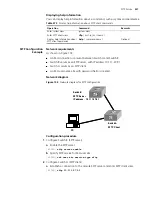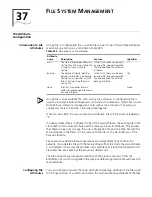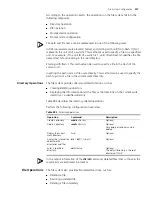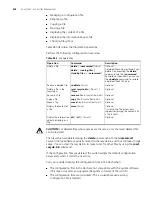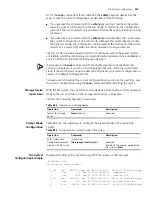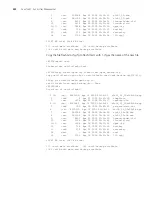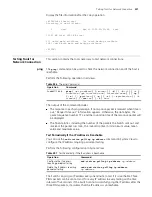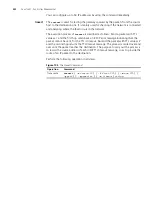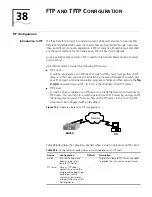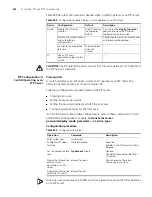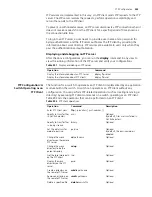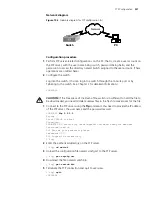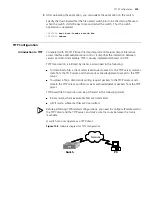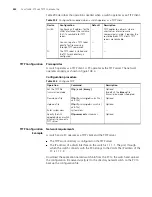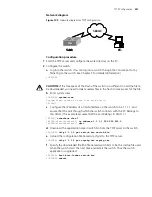
326
C
HAPTER
37: F
ILE
S
YSTEM
M
ANAGEMENT
Perform the following configuration in user view.
CAUTION:
Before configuring the main or backup attribute for a file, make sure the
file already exists. For example, to configure the main or backup attribute for a Web
file, you need to make sure the file exists on the switch.
The configuration of the main or backup attribute of a Web file takes effect
immediately without restarting the switch.
Currently, a configuration file has the extension of cfg and resides in the root
directory of a switch.
File System
Configuration
Introduction to File
System
To facilitate management on storage devices such as the Flash of a switch, Ethernet
switches provide the file system module. The file system allows users to access and
manage files and directories, such as the operations of
creating/deleting/modifying/renaming a file or a directory and displaying the contents
of a file.
By default, a switch prompts for confirmation before executing the commands which
have potential risks (for example, deleting and overwriting files).
Table 281
Configure file attributes
Operation
Command
Description
Configure the app file
with the main attribute
for the next startup
boot
boot-loader
file
-
url
Optional
Configure the app file
with the backup
attribute for the next
startup
boot
boot-loader
backup-attribute
file
-
url
Optional
Configure the attribute
(main or backup) of the
Web file for the next
startup
boot
web-package
webfile
{
backup
|
main
}
Optional
Switch the file
attributes between
main and backup for
files that are of specific
attribute
boot
attribute-switch
{
all
|
app
|
configuration
|
web
}
Optional
Specify to prompt for
the customized
password before
entering the BOOT
menu
startup bootrom-access enable
Optional
By default, a user cannot access the
BOOT menu with a customized
password.
Display the information
about the app file used
as the startup file
display boot-loader
[
unit
unit-id
]
Optional
Can be executed in any view.
Display the information
about the startup
configuration file
display startup
[
unit
unit-id
]
Содержание 4200G 12-Port
Страница 10: ...8 CONTENTS...
Страница 14: ...4 ABOUT THIS GUIDE...
Страница 46: ...32 CHAPTER 5 LOGGING IN THROUGH WEB BASED NETWORK MANAGEMENT SYSTEM...
Страница 48: ...34 CHAPTER 6 LOGGING IN THROUGH NMS...
Страница 60: ...46 CHAPTER 9 VLAN CONFIGURATION...
Страница 64: ...50 CHAPTER 10 MANAGEMENT VLAN CONFIGURATION...
Страница 80: ...66 CHAPTER 13 GVRP CONFIGURATION...
Страница 98: ...84 CHAPTER 15 LINK AGGREGATION CONFIGURATION...
Страница 112: ...98 CHAPTER 18 MAC ADDRESS TABLE MANAGEMENT...
Страница 126: ...112 CHAPTER 19 LOGGING IN THROUGH TELNET...
Страница 162: ...148 CHAPTER 20 MSTP CONFIGURATION...
Страница 274: ...260 CHAPTER 29 IGMP SNOOPING CONFIGURATION...
Страница 276: ...262 CHAPTER 30 ROUTING PORT JOIN TO MULTICAST GROUP CONFIGURATION...
Страница 298: ...284 CHAPTER 33 SNMP CONFIGURATION...
Страница 304: ...290 CHAPTER 34 RMON CONFIGURATION...
Страница 338: ...324 CHAPTER 36 SSH TERMINAL SERVICES...
Страница 356: ...342 CHAPTER 38 FTP AND TFTP CONFIGURATION...
Страница 365: ...Information Center Configuration Example 351 S4200G terminal logging...
Страница 366: ...352 CHAPTER 39 INFORMATION CENTER...
Страница 378: ...364 CHAPTER 40 BOOTROM AND HOST SOFTWARE LOADING...
Страница 384: ...370 CHAPTER 41 Basic System Configuration and Debugging...
Страница 388: ...374 CHAPTER 43 NETWORK CONNECTIVITY TEST...
Страница 406: ...392 CHAPTER 45 CONFIGURATION OF NEWLY ADDED CLUSTER FUNCTIONS...
Страница 422: ...408 CHAPTER 48 UDP HELPER CONFIGURATION...










